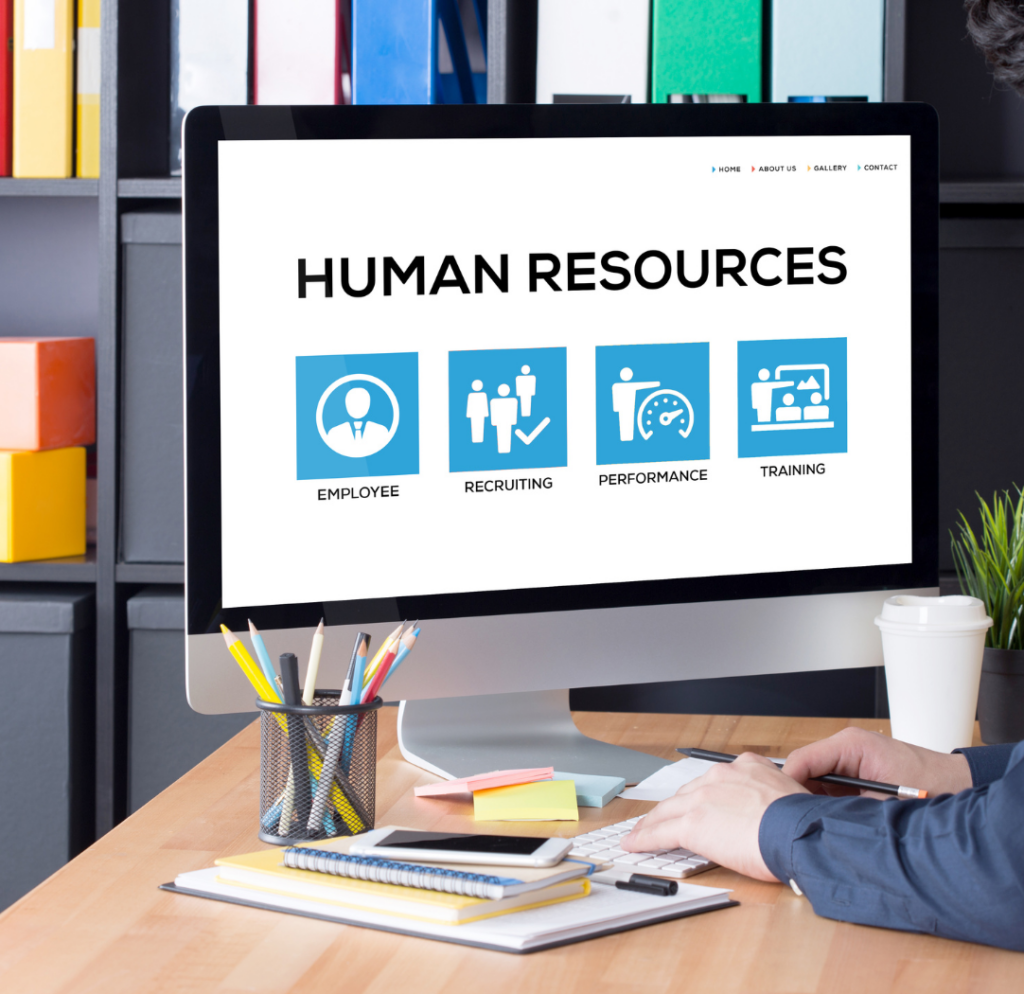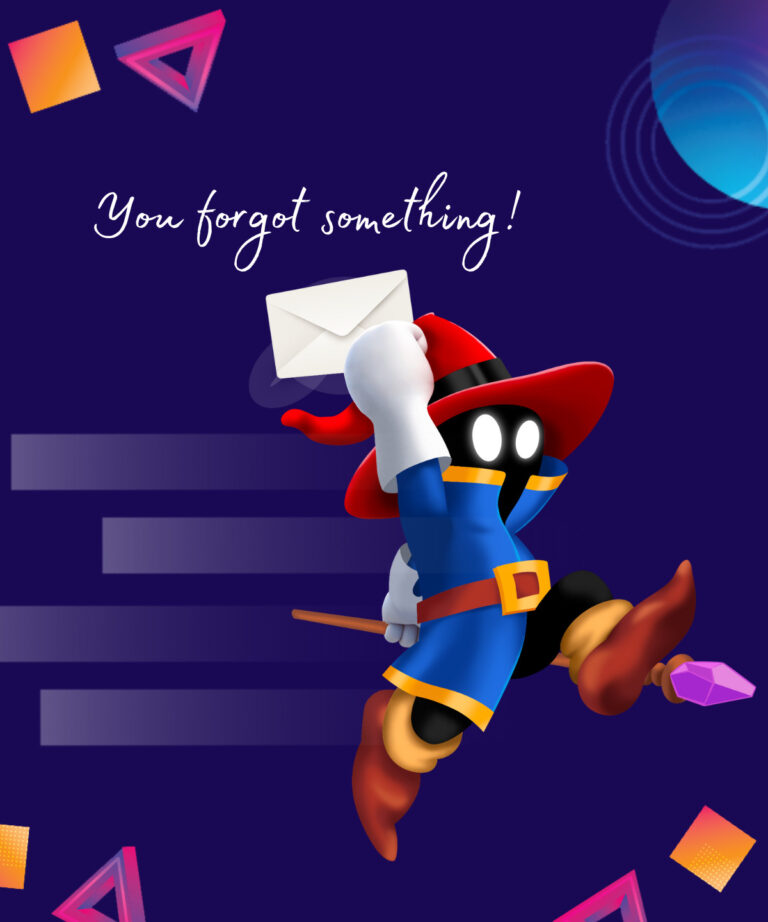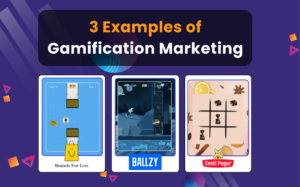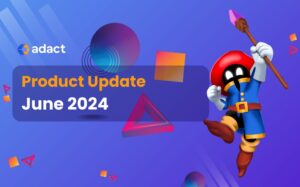Imagine that you are walking for example into a company’s sales department. As you step inside, you notice that the employees seem to be buzzing with excitement and energy. They’re not just going through the motions of their workday. They’re actually actively engaged in various tasks and challenges designed to help them improve their skills and knowledge.
You ask the HR manager what’s going on, and she explains that they’ve recently started using gamification in HR to enhance their training and development programs. Through the use of game mechanics and incentives, they’re encouraging employees to learn and grow in a fun and engaging way.
This could be your story. Since 90% of employees who rate their workplace culture as poor have thought about quitting, your goal should be to engage employees and create a strong work culture they can thrive in. Read on to learn how to implement gamification in HR, making your human resources activities more enjoyable.
What is gamification in HR?
Gamification is the process of implementing game principles into business activities.
The goal is to make some necessary but tedious tasks much more enjoyable. Furthermore – reduce stress in the working environment or make the whole organization a much more pleasant place to work.
In HR specifically, gamification techniques serve various purposes and can help with the following:
- Screening candidates
- Onboarding process
- Employee engagement
- Training
- Team chemistry
- Evaluating employee performance
Gamification will improve employee experience and the effectiveness of HR activities, as things are much more likely to stick if people learn while having fun.
How can you use gamification in HR?
If you are creative, you can gamify any HR activity. To help and give you some ideas, we will list seven HR spheres where gamification techniques will make things more effective and enjoyable.
1. Recruitment
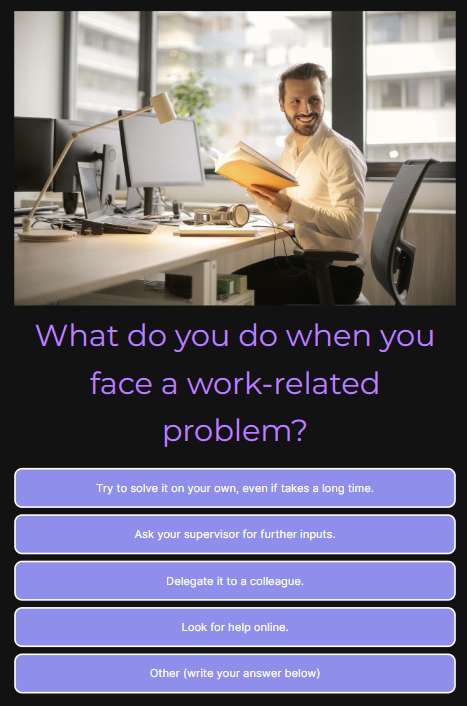
While tests and tasks will help you determine the technical and industry knowledge a candidate possesses, their innate competencies also matter—you are not hiring a robot.
Gamifying personality tests is one of the best ways to find out more about your employees during the recruitment process. Through personality tests, you will quickly determine how candidates approach problem-solving, if they are more introverted or extroverted etc. That way you can find them roles that would suit them best.
Personality tests are a great way to see how determined, competitive and conscientious they are. You can also determine their leadership qualities.
2. Onboarding

After the recruitment process is done, it’s time to onboard new colleagues, and gamification is a fun way to introduce new team members.
One of the simplest ways to check the onboarding process’s effectiveness is to quiz new employees using Adact trivia games. That way, they will not only be able to check their knowledge, but you will also find out if your onboarding HR processes need improvement if several new colleagues fail to answer the same questions.
3. Training
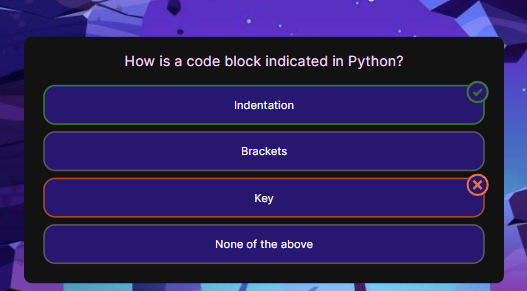
Similar to onboarding, you can use gamification in education to upgrade team members’ skills and check their knowledge. Employee training is a vital part of any organization. It will ensure each team member keeps improving and is up for the challenge of the ever-changing business environment.
You can use Adact trivia, swipe polls, multi-path quizzes and survey gamification to assess the knowledge level of each colleague. In addition, you can assign them to proper training courses accordingly and test them as they learn.
Related: Corporate training gamification
4. Employee motivation & productivity

Sometimes, the best course of action to increase employee motivation and productivity is to release some pressure. Overworked and stressed-out employees will make more errors and work less efficiently, so giving them an interactive break from time to time makes sense.
You can use Adact to create easy pass-time games that you can then email to other team members or share on Slack channels to help them release some steam. Games, such as bubble shooters or hoops, are excellent options for this. You can even set up an office leaderboard and see who was the best at the end of each week!
5. Employee engagement
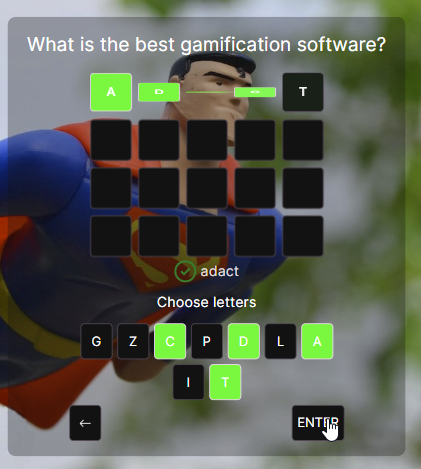
Besides increased productivity and motivation, gamification engages employees.
Employees who enjoy working at the company will remain at your company for longer. They are also more likely to praise your firm and recommend it to others. Understanding that it is not only about work and allowing them to relax through casual employee engagement games will help that process.
6. Company culture

Building a company culture takes time, but it is one of the fundamentals you should strive for. This is important not only for present employees and potential candidates but for building a brand presence. Company culture and core values also attract customers who can relate to them, turning them from buyers into genuine fans.
Gamification can help you do just that. You can engage employees, educate them about important values and survey potential candidates to ensure they are a good culture fit.
7. Team building
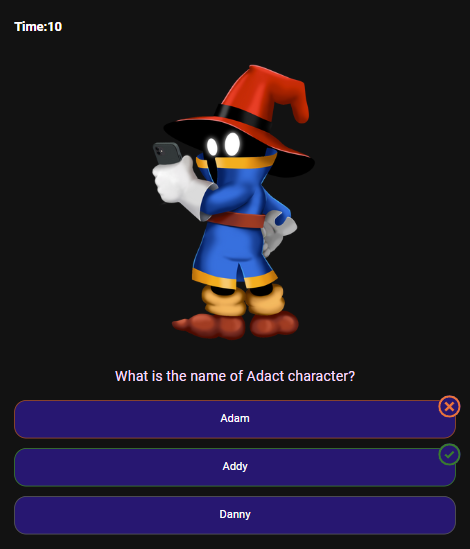
Team building activities are one of the best ways for team members to get to know each other, develop personal relationships and improve employee engagement. This is great on its own, but it will also improve productivity and work output, as people work better when they like colleagues who surround them.
Nowadays, organizing online games and team building activities is crucial, as many of us work remotely. This is where gamification comes into play. Adact can help you organize multiplayer trivia and let colleagues test their knowledge in a competitive but friendly spirit.
Check other articles on our blog if you want to learn more about gamification uses:
- Gamification for events
- Gamification for customer engagement
- Gamification for virtual meetings
- Gamification for Christmas campaigns
Gamification in HR: How to implement it
Now that you know where you can use gamification for your HR activities, let’s discuss developing a gamification strategy to do it correctly.
Plan ahead
While you can use gamification in any part of your HR activities, the best course of action is to focus on a few where it can be the most beneficial.
For example, ensuring the recruitment process and onboarding are done right will mean new employees have the necessary skills and are able to contribute in the shortest time possible. That means you should first look into those two fields and implement HR gamification to get the most out of it.
Set goals
Although some gamification elements will serve their purpose immediately after you implement them, it’s a good idea to set goals upfront so that you can measure success.
Even if you plan to use gamification for goals such as reducing stress in the work environment, running periodic surveys will help you monitor if your campaigns are accomplishing what you intend.
Also, setting goals will help you zero in on the appropriate game to choose to aid you in reaching those, as well as game principles to make it more interesting.
Choose the right tool

Gamification tools let you create fun games through an easy-to-use no-code interface, even without technical skills. Adact has customizable templates to help you get started and cut the time needed to create campaigns.
Adact will help you create gamification campaigns for your in-office and remote teammates, regardless of location. Plus, with a wide range of games, you can switch things up, ensuring games always stay fresh.
Not only your HR activities can benefit, but other departments as well. Besides gamification in HR, it works wonders in raising brand awareness and building relationships with clients.
Make it challenging but not too hard
An important rule when creating any kind of gamification in an HR campaign is to make it challenging but not too hard.
If the questions you ask are too hard, employees will get demotivated and might even feel inadequate if they need to know the answers, which is something you want to avoid.
On the other hand, if things are too easy, there won’t be enough stimulus for employees to test themselves. Not only will the game be boring, but you won’t be able to assess their knowledge if you use gamification in training.
Provide immediate feedback and create leaderboards
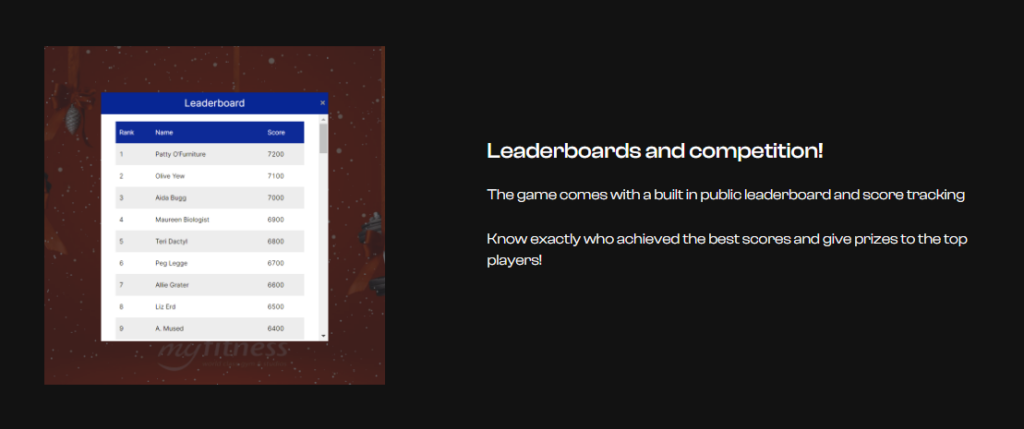
It’s also important to provide immediate feedback to employees playing games, ideally in real time. That way, they will be able to know if they made any mistakes, which will help them learn.
Leaderboards and symbolic prizes can motivate employees and nurture a healthy competitive spirit within the company. Employees will be trying to beat each other by playing games you organize.
Ask employees for feedback

The best way to understand if your gamification in the HR campaign was successful is to ask employees for feedback. Adact can help you with this, as it lets you create surveys.
Collecting feedback will allow you to improve future gamification campaigns and ensure they engage employees in a fun way while simultaneously enhancing their knowledge, productivity and relationships, depending on the goal.
Gamification in HR: Use cases
Some big companies implement unique gamification in HR strategies across their organization. If they can adopt HR gamification mechanisms for their large teams, you can do it too!
Deloitte

Deloitte, a well-known big-4 accounting firm, uses gamification in HR as an integral part of their onboarding activities. This helps their new colleagues learn about some of the most important aspects of their future activities that would be otherwise intimidating—procedures, compliance, ethics and client relationships.

Google Code Jam competition is one of the most widely known ways the tech giant attracts young talent and a great way to create a gamification strategy in their HR processes. They present coders with exciting tasks that will let them showcase their skills and creativity while simultaneously having fun.
GCHQ

An extreme example of gamification in HR, namely the hiring process, was the British intelligence and security agency. They literally asked potential candidates to play a game and crack a code in their application process, which is the only way to advance to the next step. That way, they would quickly screen candidates with the required talent for their unique positions.
Kaupmees

Kaupmees HR department used gamification to engage employees. Since the employees speak different languages, Kaupmees used the Adact automatic translation feature to create campaigns in Estonian and Russian, with nearly two-thirds of employees playing and finishing the game!
Conclusion
Whether in recruitment, onboarding, employee engagement, training, improving productivity, establishing culture or team building, gamification in HR can play a vital role if implemented right.
Adact helps you easily gamify ordinary HR tasks, making them much more enjoyable for your colleagues and thus the most effective. Try it out today and see how our templates help HR teams like yours execute gamification campaigns.
Gamification in HR: FAQs
Companies of all sizes use gamification as part of their HR activities, especially for recruitment, onboarding, training, team building, engaging employees and improving motivation.
Gamification can make employee engagement, recruitment and onboarding process more fun. It can also be used to establish company culture and create a more pleasant business environment.
Gamification helps reduce stress levels among employees and makes some otherwise tedious tasks more fun. For example, if you use gamification in employee training, you will make it much more enjoyable, which means that employees will pay more attention, thus learning more. Improving employee engagement through games will pay dividends in the future, resulting in improved job performance due to better knowledge retention.
Various personality tests are often gamified, making them more interesting for candidates while simultaneously giving insights to recruiters.
While it is used in other areas, gamification in HR is one of its most popular use cases. Gamification is a popular recruitment tool as it lets you screen how candidates think and behave in various situations that are not strictly work-related or technical. Through games, you will see candidates’ situational awareness, attention to detail, problem-solving and similar traits.
